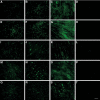Stromal cells from endometriotic lesions and endometrium from women with endometriosis have reduced decidualization capacity
- PMID: 16500320
- PMCID: PMC1626574
- DOI: 10.1016/j.fertnstert.2005.08.046
Stromal cells from endometriotic lesions and endometrium from women with endometriosis have reduced decidualization capacity
Abstract
Objective: To evaluate the phenotype, proliferative, and differentiation capacities in vitro of stromal cells derived from peritoneal, ovarian, and deeply infiltrating endometriosis.
Design: Experimental study using phase contrast microscopy, immunocytochemistry, and functional bioassays.
Setting: University-based laboratory.
Patient(s): Women with and without endometriosis undergoing surgery for benign indications.
Intervention(s): None.
Main outcome measure(s): The stability in vitro of stromal cells derived from peritoneal (n = 18), ovarian (n = 29), and deeply infiltrating (n = 14) endometriotic lesions, as well as endometrium from women with (n = 5) and without endometriosis (n = 5) was evaluated by detection of endometrial markers. The proliferative and differentiation capacity of the cells was assessed by the use of cell doubling estimation and in vitro decidualization assays.
Result(s): The expression of the progesterone receptor and CD10 in stromal cells derived from the three types of endometriotic lesions is retained in culture up to passage 10. The doubling time of stromal cells from deeply infiltrating lesions is lower than that of endometrial stromal cells. Levels of prolactin and insulin-like growth factor binding protein-1 (IGFBP-1) are reduced in supernatants from stromal cells derived from the three types of lesions and from the endometrium of women with endometriosis.
Conclusion(s): The peritoneal, ovarian, and deeply infiltrating endometriotic stromal cell lines we describe retain in vivo tissue markers. Loss of differentiation capacity of the endometriotic cell lines and endometrial cells from women with endometriosis may influence the capacity for proliferation and survival of these cells in the ectopic environment.
Figures





Similar articles
-
Membrane Progesterone Receptor Beta Regulates the Decidualization of Endometrial Stromal Cells in Women with Endometriosis.Int J Mol Sci. 2025 Jul 28;26(15):7297. doi: 10.3390/ijms26157297. Int J Mol Sci. 2025. PMID: 40806428 Free PMC article.
-
Decidualization attenuates the contractility of eutopic and ectopic endometrial stromal cells: implications for hormone therapy of endometriosis.J Clin Endocrinol Metab. 2009 Jul;94(7):2516-23. doi: 10.1210/jc.2009-0207. Epub 2009 Apr 7. J Clin Endocrinol Metab. 2009. PMID: 19351726
-
Immunohistochemical analysis of proliferative activity and steroid receptor expression in peritoneal and ovarian endometriosis.Fertil Steril. 1997 Nov;68(5):912-9. doi: 10.1016/s0015-0282(97)00341-5. Fertil Steril. 1997. PMID: 9389825
-
Molecular Basis of Impaired Decidualization in the Eutopic Endometrium of Endometriosis Patients.Cells. 2025 Feb 21;14(5):326. doi: 10.3390/cells14050326. Cells. 2025. PMID: 40072055 Free PMC article. Review.
-
[Definition, description and classification of endometriosis].Rev Prat. 1999 Feb 1;49(3):248-53. Rev Prat. 1999. PMID: 10189791 Review. French.
Cited by
-
Telocytes enhanced in vitro decidualization and mesenchymal-epithelial transition in endometrial stromal cells via Wnt/β-catenin signaling pathway.Am J Transl Res. 2020 Aug 15;12(8):4384-4396. eCollection 2020. Am J Transl Res. 2020. PMID: 32913513 Free PMC article.
-
Interaction of the conceptus and endometrium to establish pregnancy in mammals: role of interleukin 1β.Cell Tissue Res. 2012 Sep;349(3):825-38. doi: 10.1007/s00441-012-1356-1. Epub 2012 Mar 2. Cell Tissue Res. 2012. PMID: 22382391 Free PMC article. Review.
-
Unique transcriptome, pathways, and networks in the human endometrial fibroblast response to progesterone in endometriosis.Biol Reprod. 2011 Apr;84(4):801-15. doi: 10.1095/biolreprod.110.086181. Epub 2010 Sep 23. Biol Reprod. 2011. PMID: 20864642 Free PMC article.
-
Progesterone and Estrogen Signaling in the Endometrium: What Goes Wrong in Endometriosis?Int J Mol Sci. 2019 Aug 5;20(15):3822. doi: 10.3390/ijms20153822. Int J Mol Sci. 2019. PMID: 31387263 Free PMC article. Review.
-
Increased mitogen-activated protein kinase kinase/extracellularly regulated kinase activity in human endometrial stromal fibroblasts of women with endometriosis reduces 3',5'-cyclic adenosine 5'-monophosphate inhibition of cyclin D1.Endocrinology. 2009 Oct;150(10):4701-12. doi: 10.1210/en.2009-0389. Epub 2009 Jul 9. Endocrinology. 2009. PMID: 19589865 Free PMC article.
References
-
- Sampson J. The development of the implantation theory for the origin of peritoneal endometriosis. Am J Obstet Gynecol. 1940;40:549–56.
-
- Fujii S. Secondary Müllerian system and endometriosis. Am J Obstet Gynecol. 1991;165:219–25. - PubMed
-
- Nisolle M, Donnez J. Peritoneal endometriosis, ovarian endometriosis, and adenomyotic nodules of the rectovaginal septum are three different entities. Fertil Steril. 1997;68:585–96. - PubMed
-
- Osteen KG, Hill GA, Hargrove JT, Gorstein F. Development of a method to isolate and culture highly purified populations of stromal and epithelial cells from human endometrial biopsy specimens. Fertil Steril. 1989;52:965–72. - PubMed
-
- Fernandez-Shaw S, Shorter SC, Naish CE, Barlow DH, Starkey PM. Isolation and purification of human endometrial stromal and glandular cells using immunomagnetic microspheres. Hum Reprod. 1992;7:156–61. - PubMed
Publication types
MeSH terms
Substances
Grants and funding
LinkOut - more resources
Full Text Sources
Other Literature Sources
Medical
Research Materials

